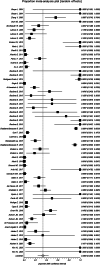Global distribution of Echinococcus granulosus genotypes in domestic and wild canids: a systematic review and meta-analysis
- PMID: 35591776
- PMCID: PMC11010506
- DOI: 10.1017/S0031182022000658
Global distribution of Echinococcus granulosus genotypes in domestic and wild canids: a systematic review and meta-analysis
Abstract
The current systematic review and meta-analysis demonstrate the genotypic distribution of canine echinococcosis worldwide. Studies published from the inception until 21 May 2021 were screened, relevant articles were selected and the random-effect model was used to draw forest plots with 95% confidence intervals (CIs). Totally, 44 articles were included, mostly examined dogs (37 records), followed by wolf (8 records), jackal (7 records), fox (3 records), pump fox (3 records) and coyote (1 record). Echinococcus granulosus sensu stricto (G1–G3) and G6/7 cluster of Echinococcus canadensis were the most common genotypes among canids. Most studies were conducted in Asia and Europe with 17 and 15 datasets, respectively. Exclusively, Iran possessed the highest number of studies (10 records). Meta-analysis showed that the pooled molecular prevalence of echinococcosis was 33.82% (95% CI 24.50–43.83%). Also, the highest and lowest prevalence of canine echinococcosis was calculated for South America (66.03%; 95% CI 25.67–95.85%) and Europe (19.01%; 95% CI 9.95–30.16%). Additionally, there were statistically significant differences between the global prevalence of echinococcosis in canines and publication year, continent, country, sample type, host and molecular test. These findings will elevate our knowledge on the poorly known canine echinococcosis worldwide.
Keywords: Canine echinococcosis; E. canadensis; E. granulosus sensu lato; E. granulosus sensu stricto; genotype diversity; meta-analysis; systematic review.
Conflict of interest statement
None.
Figures





Similar articles
-
Cystic echinococcosis in South America: systematic review of species and genotypes of Echinococcus granulosus sensu lato in humans and natural domestic hosts.Trop Med Int Health. 2016 Feb;21(2):166-75. doi: 10.1111/tmi.12647. Epub 2015 Dec 28. Trop Med Int Health. 2016. PMID: 26610060
-
Morphometrical and molecular identification of Echinococcus granulosus genotypes in wild canids in north of Iran.Vet Med Sci. 2024 Sep;10(5):e1554. doi: 10.1002/vms3.1554. Vet Med Sci. 2024. PMID: 39115453 Free PMC article.
-
Differentiation of Echinococcus granulosus sensu lato species of human origin from Neuquén, Argentina, by multivariate analysis of rostellar hooks morphometry.J Helminthol. 2025 Jul 4;99:e66. doi: 10.1017/S0022149X25100291. J Helminthol. 2025. PMID: 40611721
-
Past and present of diagnosis of echinococcosis: A review (1999-2021).Acta Trop. 2023 Jul;243:106925. doi: 10.1016/j.actatropica.2023.106925. Epub 2023 Apr 18. Acta Trop. 2023. PMID: 37080264
-
Epidemiology, molecular diversity and zoonotic implications of Echinococcus granulosus sensu stricto (G1) in cattle across Nigeria: Evidence of broader transmission dynamics.Acta Trop. 2025 Aug;268:107721. doi: 10.1016/j.actatropica.2025.107721. Epub 2025 Jun 29. Acta Trop. 2025. PMID: 40592374
Cited by
-
Effect of Nematodes-Bacteria Complex Metabolites on Cancer and Tumor Progression.Biomolecules. 2025 Aug 14;15(8):1165. doi: 10.3390/biom15081165. Biomolecules. 2025. PMID: 40867609 Free PMC article. Review.
-
Zoonotic Transmission of Hepatic Hydatid Cyst from Domestic Dogs: A Case Report from an Urban-Marginal Area in Ecuador.Am J Case Rep. 2023 Aug 14;24:e940647. doi: 10.12659/AJCR.940647. Am J Case Rep. 2023. PMID: 37574793 Free PMC article.
-
An innovative strategy for deworming dogs in Mediterranean areas highly endemic for cystic echinococcosis.Parasit Vectors. 2024 Feb 23;17(1):86. doi: 10.1186/s13071-024-06184-x. Parasit Vectors. 2024. PMID: 38395867 Free PMC article.
-
Morphometrical and Molecular Identification of Echinococcus granulosus Genotypes in peri-urban wild dogs from an endemic focus in Northwest of Iran.Arch Razi Inst. 2024 Aug 1;79(4):721-726. doi: 10.32592/ARI.2024.79.4.721. eCollection 2024 Aug. Arch Razi Inst. 2024. PMID: 40256575 Free PMC article.
-
Biochemical Properties and Immunogenic Epitopes of Echinococcus granulosus Glutathione S-Transferase as a Vaccine Target: In-Silico Study.Iran J Parasitol. 2024 Jan-Mar;19(1):61-74. doi: 10.18502/ijpa.v19i1.15205. Iran J Parasitol. 2024. PMID: 38654954 Free PMC article.
References
-
- Anvari D, Pourmalek N, Rezaei S, Fotovati A, Hosseini SA, Daryani A, Spotin A, Sarvi S, Hosseini M and Narouei MR (2021) The global status and genetic characterization of hydatidosis in camels (Camelus dromedarius): a systematic literature review with meta-analysis based on published papers. Parasitology 148, 1–54. - PMC - PubMed
-
- Arbabi M, Pestechian N, Tavasol Khamseh H, Hooshyar H and Delavari M (2017) Molecular and genotyping identification of Echinococcus granulosus from camel and dog isolates in Isfahan, Iran (2015–2016). KAUMS Journal (FEYZ) 21, 134–141.
Publication types
MeSH terms
LinkOut - more resources
Full Text Sources
Research Materials
Miscellaneous

